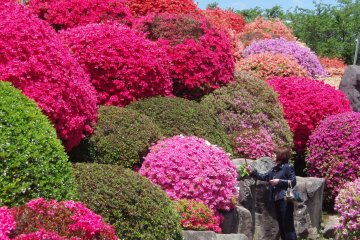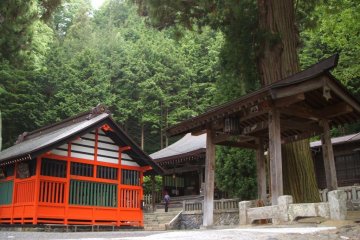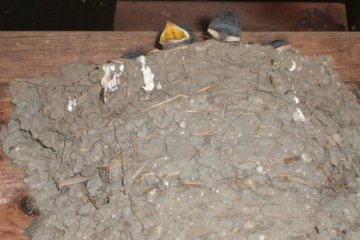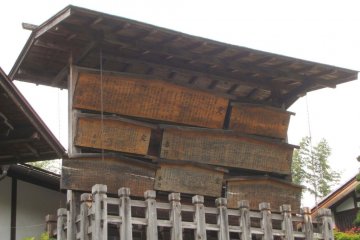The Nakasendo — 'the road through the mountains' — is one of Japan's ancient highways that was used by the pilgrims, merchants, samurai, and others to traverse to Edo (old name for Tokyo) or the towns along the road. The Nakasendo starts in Kyoto and ends in Tokyo. The entire trail is 533 kilometers. Guided walking tours for the entire road are available several times per year from WalkJapan.com.
However, if you can't take 11 days to walk the entire trail head for the Kiso Valley in Nagano Prefecture, where you can enjoy a few of the towns over a two or three day period.
We started our own two-day tour of three of the towns, Narai, Tsumago, and Magome from Narai. We drove on the Chuo Expressway from Tokyo to get there, but you can also take a train from Shinjuku. To directly access Narai from Tokyo travel by limited express train via Shiojiri.
By limited express trains via Shiojiri
Take the JR Azusa limited express train from Shinjuku Station to Shiojiri Station south of Matsumoto (2.5 hours) and transfer to a local or limited express train into the Kiso Valley. The train journey is covered by the Japan Rail Pass if you've purchased that before coming to Japan. If not, the entire one way trip from Shinjuku to Narai takes about three hours and costs around 7,000 yen.
To get to Narai take a local train from Shiojiri Station to Narai Station (20 minutes). If you prefer to start your tour from Tsumago take the Shinano limited express train from Shiojiri to Nagiso Station (50 minutes). Take care as many limited express trains do not stop at Nagiso, in which case you should transfer to a local train at Kiso-Fukushima Station or use a local train from Shiojiri. The entire one way trip from Tokyo to Nagiso by limited express trains takes about four hours and costs around 9,500 yen. From Nagiso, Tsumago can also be reached by a short taxi or bus ride.
You can also start in Magome. Take the Shinano limited express train from Shiojiri to Nakatsugawa Station (60 minutes). The entire one way trip from Tokyo to Nakatsugawa via Shiojiri takes about four hours and costs around 9,500 yen. From Nakatsugawa, Magome can be reached in a 30 minute bus ride.
It is possible to walk the trail from Narai to Tsumago, but that's an all day hike over the mountain. It's better to take the train from Narai to Nagiso and take a bus or taxi from there to Tsumago.
There is a good variety of inns and onsen to spend a night or two in any of the towns. In our case, as we drove, we stayed near Shiojiri (not on the Nakasendo, but on a nearby highway) in an onsen (hot springs spa), Koma-no-yu Ryokan & Onsen.
After checking in and having a refreshing beer we headed out for a walk up the road and through a campground that has over 20 small cabins (very basic, sleeping only) if you're the camping sort.
Back from our walk and time to hit the ofuro (bath). The water in this onsen is very pure and used to contain so much iron that towels in the bath would turn red. The water is filtered now and is just the right temperature for a nice soak. I preferred the outdoor bath (rotenburo) and the air was just cool enough to make the hot water feel great!
Like most all ryokan (inn) in Japan dinner and breakfast were included in the price. Dinner at Koma-no-yu consisted of several courses so naturally, you may want to have several "courses" of sake, too! We tried 4 brands of the locally made sake and wound up stopping at the sake brewery the next day to buy a couple of bottles to bring home.
Dinner starts with the amuse bouche - Japanese style, then moves on to the appetizers and then and the entree, followed by tempura, followed by dessert. Plenty of food for the hungriest of travelers.
After this satisfying meal head back to your rooms and then off to the baths once more (part of the onsen experience is going to the baths several times) before the Japanese sandman takes over and sends you off to slumberland.
Upon awaking the next morning we enjoyed a typical Japanese breakfast, but the surprise at this ryokan was that they had a pot of coffee on the sideboard which was very, very good - must be the water! Or maybe it really just tastes better when you're trying to get rid of a sake induced heavy head.
Narai lies about 20 km. north of this onsen on Route 19. During the Edo Period Narai was the halfway point between Kyoto and Edo (the old name for Tokyo) for travelers along the Nakasendo. It was the most wealthy post town of the Kiso Valley. We were there early - about 09:30 - before the crowds so our stroll through the long street was very pleasant and not crowded.
Tsumago, which was another of the stops along the Nakasendo for the weary Edo era travelers (remember, these people were walking with a big entourage, paladins, and enough baggage to last for several weeks and it took them many weeks to make this journey).
In ancient times everyone coming into Tsumago was checked before they were allowed to enter and all had to read the town's laws, which are still posted on these old wooden placards, and promise that they would obey them!
Tsumago is known today as one of the best preserved post towns in Japan. The town and its residents go to great lengths to recreate the ambiance of the Edo period. Cars are prohibited on the main street during the day, and phone lines and power cables are concealed underground, allowing visitors to imagine they have slipped back to an earlier time.
As we walked down the street of Tsumago the swallows were busy with their babies in nests built under the eaves of the shop houses. We watched one momma swallow as she flew back and forth with some morsel for her hungry babies (4 in the nest). It was intriguing to see that she remembered where she had left off each trip. If she started with baby number one on the right and ran out of food by baby number three, on the next trip she would start with baby four and work her way back across again.
Look carefully at the photo of the baby swallows and you'll be able to count 4 little heads. Baby three has its mouth wide open yelling for more food. Baby two is fast asleep and if you look really, really carefully you'll see he (she?) has a little tuft of hair on top of his/her head - sort of like Woodstock the bird in the Peanuts cartoons.
If you choose to do the walk between Tsumago and Magome, the next town, plan on it taking from 2 to 4 hours - the actual time required depends on who you ask - but since one of the people who told is a local, and she said 4 hours, that's what we'll plan on when we go back to do the walk.
In our case we drove to Magome where we walked down, down, down the long hill of the town (guess what that means - yep, coming back to the car means we walked up, up, up!).
Magome has been beautifully restored with a broad stone walkway lined with carefully tended foliage. Magome's embellished preservation contrasts sharply with the rugged authenticity of Tsumago.
All 'walked out' it was time to head back to modern day Edo (Tokyo). Back on the Chuo Expressway we made good time till we got to Sagamiko where once again the roads showing on the GPS navigation system in the car were bright red - meaning traffic jam. Rather than sit in the traffic we pulled into one of the highway system's very well appointed rest stops where we had dinner and gave the traffic a bit of time to clear out. Sure enough, that did the trick, and we moved along at a decent pace all the way back into town.
If you can plan your trip to the Kiso Valley in the autumn you can expect that the foliage will be bright and beautiful making the walk between the villages even more pleasant.









